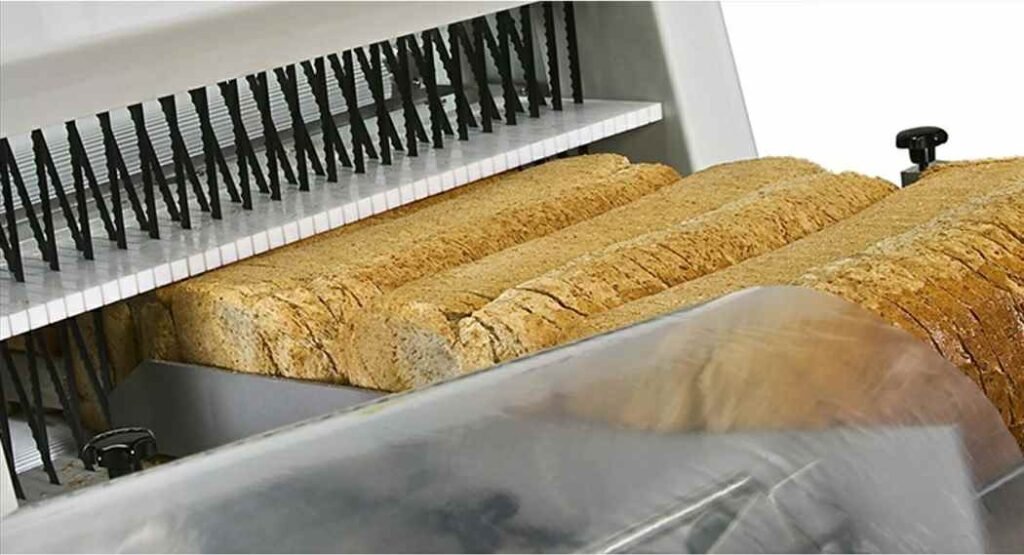In bustling bakeries and kitchens, the alluring scent of freshly baked bread often accompanies an often-overlooked hero—the bread slicing machine. Join us on a journey to unravel the intricacies of these machines, elucidating their common wear parts, and delving into the captivating realm of bread slicing blades.

The bread slicing machine, a commonplace apparatus in bakeries and baking kitchens, encompasses several commonly used vulnerable components that may require periodic inspection and replacement during machine usage.
1.Here are the common names of vulnerable parts in bread slicing machines and their functions:
1)Slicing Blades: These are the core components of bread slicing machines, responsible for evenly slicing bread. Typically, these are sharp disc-shaped blades that can be adjusted to achieve the desired thickness.
2) Guides: Guides ensure that the bread stays in the correct position during the slicing process, stabilizing it and ensuring uniform slices.
3) Blade Guard: A crucial component, the blade guard protects operators from accidental injuries. It covers the slicing blades, ensuring hands do not come into contact with them during slicing.
4) Bread Tray: Serving as a platform for placing the bread to be sliced, the bread tray is usually movable, allowing operators to easily position the bread correctly.
5) Drive Belt: The drive belt is a component in the bread slicing machine responsible for transmitting power. It connects the motor to the slicing blades, enabling them to rotate for cutting.
6) Motor: The motor is the power source for the bread slicing machine, providing the necessary force to drive the slicing blades for cutting.
7) Switches and Buttons: Used to control the startup, shutdown, and other operations of the bread slicing machine, switches and buttons serve as the interface for interaction between operators and the machine.
8) Adjustment Handles: Adjustment handles are used to modify the cutting thickness of the slicing blades. By rotating the adjustment handles, operators can change the thickness of the slices to accommodate different types of bread.

2. Understanding Bread Slicing Blades: Shapes and Applications
Bread slicing blades come in various shapes, each designed for specific scenarios:
1)Straight Blades:
Features: Versatile, straight blades are well-suited for general cutting tasks, such as various types of bread.
Applications: Bakeries, restaurants, and daily bread slicing in households.
2) Serrated Blades:
Features: The wavy edge design makes serrated blades ideal for handling bread with a crispy outer layer, such as baguettes.
Applications: Cutting artisan bread, baguettes, or any bread with a hard crust.
3) Disc Blades:
Features: Disc blades provide precise and uniform cutting, suitable for various bread types, including sandwich bread.
Applications: Industrial bread production requiring consistent cutting.
4) V-Shaped Blades:
Features: The V-shaped design is ideal for soft bread, preventing deformation during cutting.
Applications: Slicing soft bread, sandwich bread, or soft pastries.
5) Concave Blades:
Features: Concave blades protrude outward, making them suitable for moist bread without easy damage during cutting.
Applications: Cutting freshly baked moist bread or soft fruits.
6) Wheel Blades:
Features: Wheel blades are typically used in high-speed environments for quick bread cutting, making them ideal for fast-food establishments.
Applications: Fast-food restaurants and high-production environments.

3. Common Slicing Blade Materials and Their Pros and Cons
The material of bread slicing blades affects their performance and durability. Let’s explore the most common materials:
1) Stainless Steel:
Pros: Corrosion-resistant, wear-resistant, easy to clean.
Cons: May not retain sharpness as well as some other materials.
2) Carbon Steel:
Pros: High hardness, excellent sharpness.
Cons: Prone to rust and requires regular maintenance.
3) Ceramic:
Pros: Extremely hard, corrosion-resistant, does not transfer odors.
Cons: Fragile, not suitable for bending stress.
4) Alloy Steel:
Pros: Combines hardness and corrosion resistance.
Cons: Relatively heavy, may not maintain sharpness as well as other materials.

In conclusion, in the world of bread slicing machines, we find a perfect blend of precision engineering and practicality. Understanding the subtle differences in blade shapes and materials allows bakers and kitchen enthusiasts to make informed choices, ensuring a seamless and efficient bread slicing experience. Whether you’re slicing crusty baguettes or delicate pastries, the right blade plays a pivotal role in the world of bread slicing. Therefore, let’s pay homage to this quietly dedicated hero—the bread slicing machine—for bringing uniformity and perfection to our daily bread.
4. About METAL Industrial
Nanjing Metal Industrial CO., Limited is a manufacturer of mechanical blades from China, producing blades and accessories for industries including metalworking, converting, food, and more. We have more than 15 years of experience in the manufacture and sales of industrial machine blades, machine parts, and regrinding services. We invite you to experience the superior quality of production.


